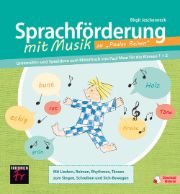Dreamlands with new texts
In Birgit Jeschonneck's book "Sprachförderung mit Musik", well-known folk songs help children in grades 1 and 2 to make unfamiliar terms their own.

It all seems so light, so playful, so inspiring! Birgit Jeschonneck's book Language development with music is intended for first and second grade teachers, especially those who teach children whose first language is not German. The concept is clear and easy to understand: the children visit four dream lands invented by children's author Paul Maar. There is the colorful land of circles, the land of 1000 corners, the land of red tones and finally the small land of upside down. Jeschonneck sets clear educational objectives for each of these countries: The children should look for round or angular objects in the classroom, such as the round heating thermostat, the round clock, the angular table or the geo triangle. They learn new terms along the way.
Now each dreamland has its own well-known folk song, into which found objects are integrated using a parody technique. "The cupboard has eight corners, the cupboard has eight corners", is one example. Or the children write poetry to the tune of Green, green, green are all my clothes new lines such as: "... because my favorite thing is the fire alarm". The children playfully develop a feeling for the structure of the German language, for articles and for hyphenation.
Not every teacher will be able to go through the whole book. But the German or music teacher can use a lot of it for exciting, inclusive lessons that promote creativity and combine learning with fun. The almost 100-page book is also highly recommended for home use. In addition to many illuminating examples, there is a beautifully produced CD and a stimulating theoretical section for further reflection.
Birgit Jeschonneck: Language development with music for "Paula's Travels". Teaching and play ideas for the picture book by Paul Maar for grades 1+2, 99 pages, with CD, € 21.95, Friedrich-Verlag, Hanover 2019, ISBN 978-3-617-92026-8









